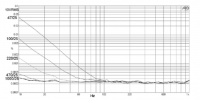I think you are misapplying this app note. It is specifically for "high speed op amps" as stated in the title. TI defines those as having "gain bandwidth product (GBW) ranging from 50 MHz to 8 GHz". The author refers to "microwave capacitors" in multiple places. This is not the type of op amp we are discussing here. The GBW of the NE5532 is 10MHz, and there are no microwave capacitors on either the TPA3255evm nor the Aiyima board.
The decoupling capacitor is very much for stability. The GBW of the op amp is 10MHz. The self resonance frequency of the
C0603C104K5RACTU cap is 20-30MHz, so it is not providing in-band filtering at its self resonance. It is located close to the op amp to minimize the PC board inductance in series with the op amp supply, to avoid an unintentional feedback path in the op amp due to inductive voltage drop on the supply.
When the op amp drives its output load, the current drawn from the supply will generate a voltage across any series inductance in the supply lead. The voltage across the inductor leads the current, but as the voltage drop is inverted with respect to the output voltage, that creates a lag instead of a lead relative to the output voltage. This voltage couples into the internal signal path, especially at high frequencies where the PSRR is poor. The resulting phase of the injected signal now depends on the output load impedance, the impedance at the supply pin, and the internal circuit topology of the op amp. Two of these things are out of the designers hands. The effect can be highly variable, but it will likely reduce phase or gain margin. Some op amps can definitely be observed to oscillate under such conditions.
This is an uncontrolled nested feedback problem that no IC designer wants to deal with. Requiring a 0.1uF ceramic cap very close to the supply pins bounds this problem and largely eliminates PCB inductance concerns at the supply pin.
Agreed, those caps are primarily for stability.


